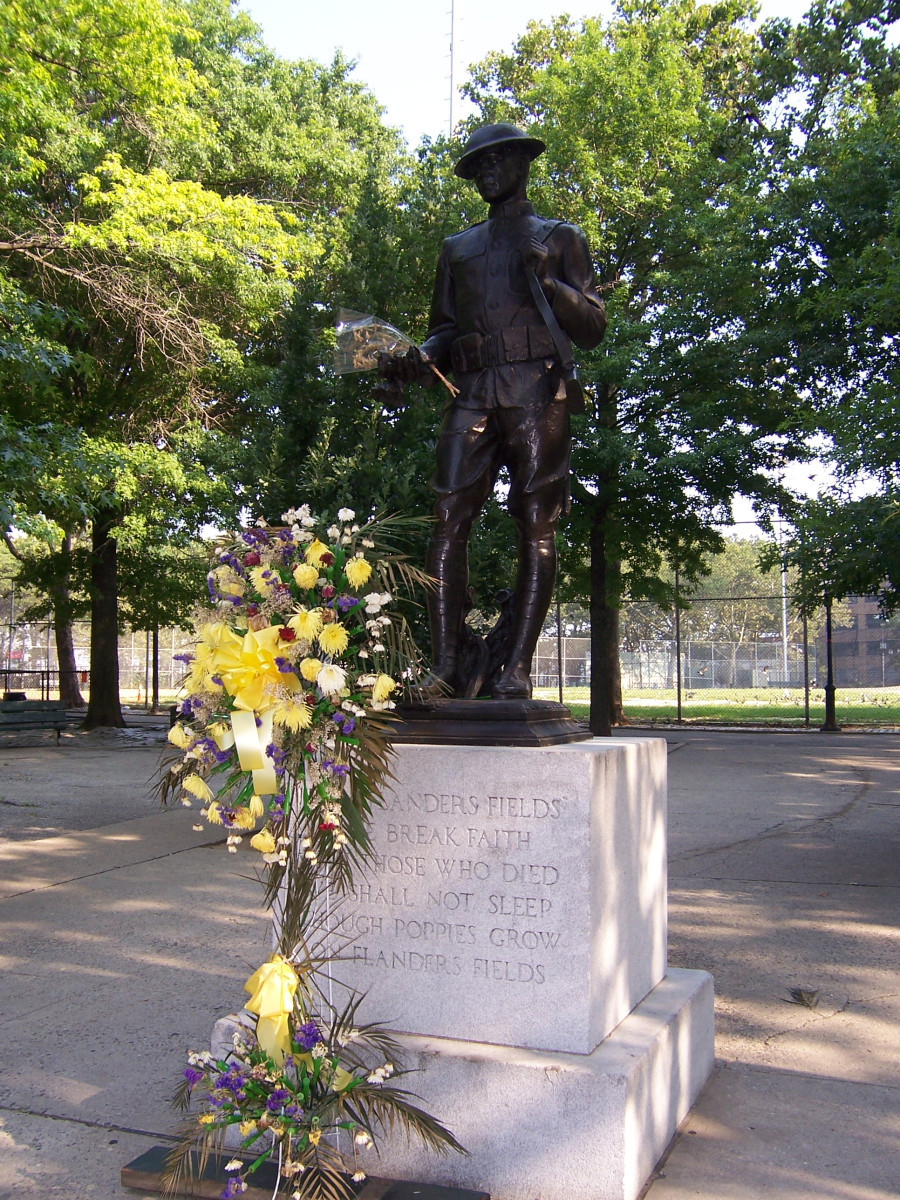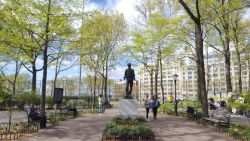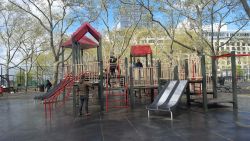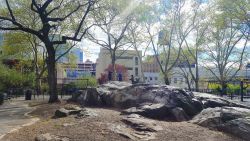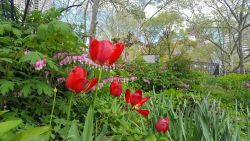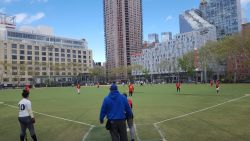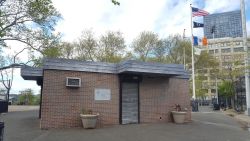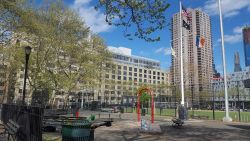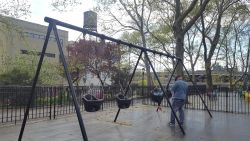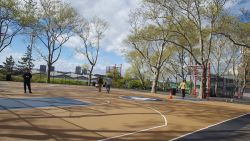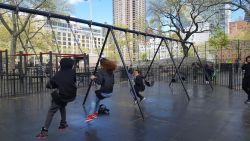De Witt Clinton Park
View all monuments in NYC Parks, as well as temporary public art installations on our NYC Public Art Map and Guide.
Clinton War Memorial (Doughboy)
| Artist: | Burt W. Johnson |
| Dedicated: | November 11, 1929 |
| Location: | 11th Avenue and 53rd Street |
Artwork History
This poignant monument is the work of sculptor Burt W. Johnson (1890-1927) and architect Harvey Wiley Corbett. It was commissioned by the Clinton District Association as a memorial to the young men from the neighborhood who died in World War I, and was dedicated on June 8, 1930. The monument features a pensive infantryman known as a “doughboy” holding poppies in his right hand and a rifle slung over his left shoulder. The granite pedestal is inscribed with a verse from the famous poem by John McCrae (1872-1918), In Flanders Fields.
The arrival of the American Expeditionary Force in June 1917 tipped the balance in favor of the Allied Forces towards the middle of 1918. The four American divisions, 40,000 men in all, who fought in Flanders, arrived in Europe in June and July 1918. The 27th and 30th Divisions were engaged in battle on the front, south of Ypres. The 37th and 91st Divisions led an attack near the Flemish towns of Waregem and Kruishoutem. The Americans suffered heavy losses, particularly in the Spitaalsbossen, not far from the present day Flanders Fields American Cemetery and Memorial in Waregem, which commemorates the 368 dead and 43 missing soldiers on Belgian territory during World War I.
McCrae was a Canadian physician and lieutenant colonel who was inspired to write the poem in response to the death of his friend and fellow soldier, Alexis Helmer, who gave his life in the Second Battle of Ypres—a series of military engagements in which many thousands of soldiers died in 1915 in western Belgium. The lines of the poem have resonated for generations, and its image of poppies has become a symbol of loss and remembrance. Johnson selected the motif for the floral tribute carried by his doughboy and the inscription.
The term doughboy was widely popularized in the United States during World War I (1914-1918) to refer to infantrymen. After the war numerous communities commissioned doughboy statues to honor local war heroes. The Clinton War Memorial’s is one of nine such statues erected in New York City’s parks.
Burt Johnson was born in Flint, Ohio. He studied with noted sculptors James Earle Fraser and Louis Saint-Gaudens, Johnson’s brother-in-law, whose sibling was the renowned artist Augustus Saint-Gaudens. Receiving many public commissions from coast to coast, Johnson also created the statue for the Woodside Doughboy (1923) in Doughboy Park in Queens.
Johnson died prematurely soon after modeling this sculpture and while completing work on the Fine Arts Building in Los Angeles. At the time of his death he resided in Claremont, California, where he had sculpted one of his best-known works, the Spanish Music Fountain for the campus of Pomona College. Though he had finished the model for the Clinton doughboy, it was left to his widow Ottilie to come to New York to arrange the casting of the sculpture by Gorham Bronze and the posthumous completion of the monument. The sculpture was situated at the highest point of the historic park which at the time served a densely populated working-class tenement district that abutted an active waterfront.
The intended date of dedication (as inscribed on the pedestal) was Armistice Day (now Veterans Day) 1929, but the event was postponed to June 8, 1930 and the unveiling took place more than two years after Johnson had died. The festivities commenced with a parade from 40th Street and 10th Avenue to the monument site, and the principal address was delivered by James S. Gerard, the former ambassador to Germany.
In 1997, the sculpture was conserved through a project jointly sponsored by the Times Square Business Improvement District and the Mayor’s Office of Youth Empowerment Services. In 2009 a City-funded capital improvement renovated the surrounding plaza and added a planting bed in front of the sculpture. In 2014 the Government of Flanders, Belgium sponsored the monument and plaza’s care and landscaping for seven years in conjunction with the commemoration of the centennial of World War I.
In an unpublished speech delivered at Pomona College in 1924, Johnson commented on the important neighborhood and societal role of statues such as this: “Civic sculpture, its subject, its placement and its execution make it a part of the life of the community.” It is a tribute to Johnson’s artistry that though the city and neighborhood may have evolved, his doughboy’s emotive power has endured for future generations.
Artwork Details
| Description: | Standing figure (over life size) with integral plinth, on pedestal |
| Architect: | Harvey W. Corbett |
| Materials: | Bronze, North Jay granite |
| Dimensions: | H: 12' W: 4'8" D: 4'8" |
| Foundry: | Gorham |
| Donor: | Clinton District Memorial Association. |
| Cast: | ca. 1927 |
Inscription
Pedestal front:FROM 'FLANDERS FIELDS' / IF YE BREAK FAITH / WITH THOSE WHO DIED / WE SHALL NOT SLEEP / THOUGH POPPIES GROW / ON FLANDERS FIELDS /
Pedestal rear:
DEDICATED / MEMORIAL DAY 1930/ BY COMRADES AND FRIENDS / UNDER THE AUSPICES OF / CLINTON DISTRICT MONUMENT / ASSOCIATION AS A MEMORIAL / TO THE YOUNG FOLK OF THIS NEIGHBORHOOD / WHO GAVE THEIR ALL IN THE WORLD WAR /
Please note, the NAME field includes a primary designation as well as alternate namingsoften in common or popular usage. The DEDICATED field refers to the most recent dedication, most often, butnot necessarily the original dedication date. If the monument did not have a formal dedication, the yearlisted reflects the date of installation.
For more information, please contact Art & Antiquities at (212) 360-8163.
Check out your park's Vital Signs
Clean & Safe
Green & Resilient
Empowered & Engaged Users
Share your feedback or learn more about how this park is part of a
Vital Park System
